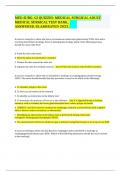4.
A nurse is caring for a client who is dehydrated and is receiving continuous tube feeding through a
pump at 75 mL/hr. When the nurse assesses the client at 0800, which of the following findings
requires intervention by the nurse?
Answer: A. A full pitcher of water is sitting on the clients bedside table within the clients reach.
B. The disposable feeding bag from the previous day at 1000, and contains 200 mL of feeding.
C. The client is lying on the right side with a visible dependent loop in the feeding tube.
D. The head of the bed is elevated 20 degrees. - Ans-A. the nurse should monitor the clients intake
and output and should observe the client for manifestations of dehydration, such as dry mucous
membranes, thirst, and decreased urinary output. A pitcher of water at the clients bedside does
not require intervention by the nurse.
B. The clients feeding bag should be changed every 24 hrs. The 200 mL remaining in the bag is
sufficient to last until the bag needs to be changed. Because the rate is 75 mL/hr, the nurse will
need 150 mL to cover the 2 hr until the bag needs to be changed. The 50 mL left in the bag will
ensure that the bag does not run dry, causing air to enter the clients stomach.
C. This observation does not require intervention because the feeding is not by gravity, but by a
pump. and is set at a constant rate. The clients side-lying position will not affect the pump\'s rate of
flow unless the client is lying on the tubing.
D. CORRECT: The head of the bed should be elevated at least 30. (Semi-Fowler\'s position) while the
tube feeding is administered. This position uses gravity to help the feeding move down through the
digestive system and lessens the possibility of regurgitation.




